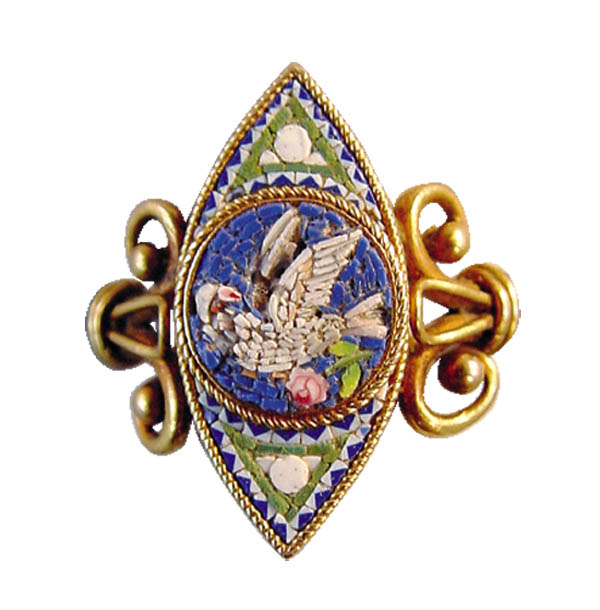Souvenir Jewelry Of The Grand Tour And The British Isles
Historically inspired jewelry was prompted in the Victorian era by the study of ancient Pompeii, Egypt, Greece and Rome. These motifs included designs from wall paintings, floor tiles and excavated jewelry. Heavier Renaissance and Medieval style jewelry combined well with the heavier Victorian fashions as well, and later in the 19th century Oriental motifs provided further inspiration. Plant collecting was a passionate Victorian hobby, and these natural motifs were also reflected in jewelry. Amazing novelty jewelry was made of everything from small real birds to beetles and other insects. What we today might think grotesque they saw as innovative, and reflective of their interest in nature, science and leisure activities. Mosaics as a form of art and decoration go back literally thousands of years to the ancient world. Mosaics can be seen as early as Mesopotamia, and the Greeks and Romans with their wonderful mosaics were studied by many of us in high school. Used mostly for decorating walls and pavements, it later became popularly used in jewelry as well.
Mosaics were made primarily in Italy, and there are two kinds of mosaic inlay techniques which have been practiced there for hundreds of years, "pietra dura" and "mosaic" work. They were created in two different cities, pietra dura in Florence and mosaics in Rome. Pietra dura, in Italian, means "hard stone", and it has the look of a jigsaw puzzle with closely fitting pieces on a black background. The materials were often so closely fitted together that the seams were all but invisible, and the stones used included semi-precious malachite, lapis, aventurine and turquoise. Mosaic and micro mosaic work uses inlaid glass tessera or rods fitted closely to form landscapes and other motifs like doves or flowers. Mosaic jewelry was made by setting the colored pieces into a black cement or mortar background. Pictures and shading were created by using different colored pieces. Once travel became popular, these were produced in greater quantities to supply the tourist trade. To determine quality, look for small elements with well made closely fitting designs. Pieces set in karat gold may command higher prices too, but only if the workmanship is of great quality.
Older mosaic pieces tend to be more intricate and well-made, with smaller pieces to form the mosaics and often done in softer colors with greater detail. There can be hundreds of pieces in a single inch of the very best mosaics. They are also more often set in karat gold than the 20th century pieces, which were generally made for a mass market and a lower price point. A mosaic missing any of the tiny pieces will be of lower value, so look closely when buying. Also watch for breaks in the black background. Treat these little pieces with the care they deserve as they can be damaged, and once damaged, are all but impossible to repair.
CAMEOS
What is more classic and timeless than a cameo? Though they long pre-date the Victorian era, for Victorians who loved travel a cameo represented a meaningful and wearable souvenir of a Grand European Tour, and could be passed down from generation to generation. Both men and women wore cameos set as necklaces and brooches, as well as rings and earrings for women, and watch fobs, rings and stick pins for men. The Victorian fascination with all things historic is demonstrated in the classical Greek profiles and mythological motifs. Reflecting the Victorians love of gardening and nature, floral cameos were also popular in the later Victorian era. Carved in seashell, ivory, jet, lava or stone, cameos could be set in precious or non-precious metals. Some cameos are portraits of real people, some of gods and goddesses or mythological characters, and some of just attractive ladies and gentlemen. Although thought of as primarily an Italian art, there were also cameo carvers in America and other countries. The quality and beauty of carving is the prime factor determining value, but cameos set in precious metal ornamented with diamonds, seed pearls or enameling are most desirable. When buying a cameo, be sure to check its condition by holding the cameo up to the light to detect possible cracks. There is no way to repair a broken cameo so buy selectively.
AGATE
British souvenir jewelry came along with the easier transportation during the early decades of Queen Victoria's reign when the English were riding on trains to see parts of their country that were farther away and harder to reach traveling by horse. Public transportation made vacations within the British Isles more available to the masses, and along with that came the souvenir jewelry from some of the different vacations spots. The popularity of Victorian Scottish stone or "pebble" jewelry was encouraged by Queen Victoria and it began as a souvenir of her trips to Scotland. From the mid-1800s Queen Victoria frequented Scotland and her Scottish castle, Balmoral, and Scotland became a popular place to view the sites, with Scottish dress and jewelry being fashionable, too. By the later 1800s it was being made in England and Germany as well. Agate comes in many colors and the lovely or unusual striations can add to their desirability. Usually set in silver, they did set some pieces in both karat gold and jeweler's metal as well. The stones themselves included jasper, bloodstone and other agates, and some were also set with Cairngorms citrines and amethysts. Worn with everything from Levis to the typical plaids, these cannot be beat as a wonderful accessory. The price of Victorian agate jewelry has almost doubled in the past 10 years, so get yours while you can. Watch that the settings are intact and the agates well set into the piece.
JET
During the part of the Victorian period from about 1860 to 1890, Whitby jet jewelry was the height of fashion and black was a stylish color, not just an ornament of mourning. Although it had been made in Whitby years before, when Queen Victoria began wearing it, its popularity exploded. Black jewelry was made of jet, vulcanite, bog oak or pressed horn, and while some pieces were just beautifully carved, others carried a special meaning as a memento of a loved one. A brooch in the shape of a hand carrying a bouquet conveyed a message symbolized by the flowers. Photos might be housed inside lockets and watch fobs, and portraits hand painted on pendants and earrings. While some black jewelry was meant to be worn during mourning, black jewelry was fashionable as well, and worn for its beauty and sentiment alone. It is not always easy to determine which black material has been used, there are determining factors. For photographs and information on identifying these materials, see http://www.morninggloryantiques.com/collectVictJetPins.html. Jet was the most expensive and difficult to make of all the black jewelry. Jet was hand carved, while the other materials were pressed or molded. Jet is the black fossilized wood of a particular tree that grew millions of years ago. It is particularly associated with the English town of Whitby where the best jet was mined and much of it was fashioned into jewelry and accessories, and to a simplified degree, it still made today. While jet was made into jewelry throughout the 1800's, it was especially fashionable between 1860 and 1890. Like amber, it will pick up paper when static is created by rubbing it on wool or silk. IDENTIFICATION: Jet brooches will have an applied pin back rather than using screws. An inset back would indicate that the piece is vulcanite or another black material, not jet. Jet chains have links with two duplicate pieces which are pegged and then glued together. Vulcanite links are all one piece with a slit in one end to insert the next link. This can be done because vulcanite is malleable, unlike jet which is brittle and hard. Jet lockets are smooth inside while vulcanite lockets are textured with a design inside. Signed pieces are very hard to find, and when found they are usually extremely well-carved. The jet workers only signed their very best pieces and these pieces were sometimes carved for a competition. Buy from a reputable dealer who knows jet jewelry and will stand behind what they sell as there are reproductions being made. NO MATTER WHICH VICTORIAN ERA SOUVENIR JEWELRY you prefer, all have an interesting history, and all are delightful to wear and collect!
Editors Note: Jane H. Clarke is the proprietor of Morning Glory Antiques & Jewelry at the Antique Connection Mall Albuquerque, New Mexico. Visit online at www.morninggloryjewelry.com to see her incredible inventory.














